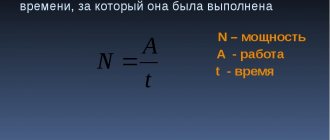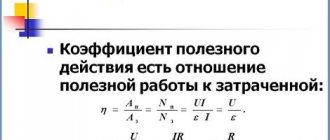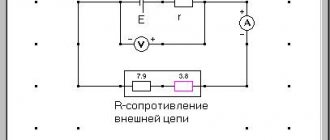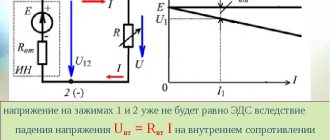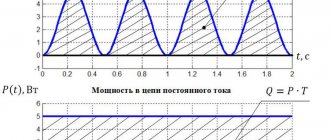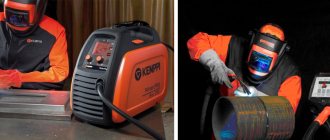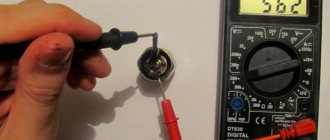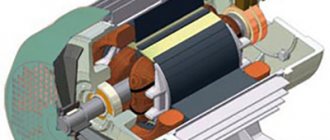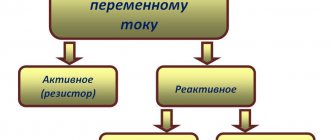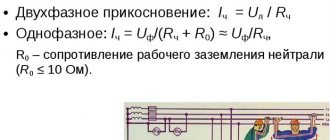In the process of moving charges inside a closed circuit, a certain amount of work is performed by the current source. It can be useful and complete. In the first case, the current source moves charges in the external circuit, while doing work, and in the second case, the charges move throughout the entire circuit. In this process, the efficiency of the current source, defined as the ratio of the external and total resistance of the circuit, is of great importance. If the internal resistance of the source and the external resistance of the load are equal, half of the total power will be lost in the source itself, and the other half will be released at the load. In this case, the efficiency will be 0.5 or 50%.
What is a current source
This is a device or element, in the general sense, a two-terminal network in which the current passing through it does not depend on the voltage at the poles. Main characteristics of the current source (IT):
- size;
- internal conductivity (impedance).
The internal resistance of such a two-terminal network is very small. At an ideal source (IIT) it approaches zero.
Graphic designation and current-voltage characteristic (volt-ampere characteristic) IT
Electron motion generators can be either independent or dependent.
The first are an ideal two-terminal network, with two terminals. In them, the current moving from one terminal to another does not depend on the shape and magnitude of the potential difference across the terminals. Its changes occur according to their own laws.
The second type of IT is an ideal two-terminal network, with two terminals, in which the movement of charges from one terminal to another depends on the shape and magnitude of the voltage at these terminals.
There is managed dependent IT. It is an ideal two-terminal network, having 2 input terminals and 2 output terminals. Its peculiarity is that the output current value at the output depends on its value at the input. In such IT there is an increase in power. By changing the zero power value at its input, the amount of power at the output terminals is controlled.
Information. The energy producer can be controlled by voltage (ITUN) or current (ITUT). Some are used for field-effect triodes and vacuum tubes, while others are used for bipolar transistors.
In reality, current generators have certain voltage limitations. They are far from ideal IT and create the movement of electricity in a voltage range where their upper limit depends on Upit IT. Therefore, a real current source has significant load limits.
pros
- Due to the fact that there are no moving parts or elements in the panels, durability increases. Manufacturers guarantee a service life of 25 years.
- If all routine maintenance and operating rules are followed, the life of such systems increases to 50 years. Maintenance is quite simple - promptly clean the photocells from dust, snow and other natural contaminants.
- It is the durability of the system that is the determining factor for the purchase and installation of panels. After all costs have paid for themselves, the generated electricity will be free.
The most important obstacle to the widespread use of such systems is their high cost. Given the low efficiency of household solar panels, there are serious doubts about the economic necessity of this particular method of generating electricity.
But again, it is necessary to reasonably assess the capabilities of these systems and, based on this, calculate the expected return. It will not be possible to completely replace traditional electricity, but it is quite possible to save money by using solar systems.
In addition, it is difficult not to notice such benefits as:
- Receiving electricity in the most remote areas from civilization;
- Autonomy;
- Silence.
Electrical circuit efficiency
By moving charges through a closed circuit, the two-terminal network does some work. When a generator moves charges along the outer circuit of a circuit, this is useful work. When IT moves electrical media throughout the chain, it is said to be fully operational.
Attention! In this chain of charge movement, the efficiency (efficiency factor) of the source is of particular importance. It is equal to the ratio of the external circuit resistance and the total resistance of the circuit.
Paying attention to the efficiency of an electrical circuit, it should be noted that it directly depends on the physical quantities that determine the speed of transmission or transformation of electrical energy. One of these quantities is power P (W).
Power formulas:
P = U * I = U2/R = I2 * R,
Where:
- U – load voltage, V;
- I – current, A;
- R – load resistance, Ohm.
For different circuits, the voltage and current values are different, therefore, the work they produce will be different. When it comes to estimating the speed of transmission and transformation of electric current, pay attention to P. It corresponds to the work done per unit of time:
P = A/∆t,
Where:
- P – power, W;
- A – work, J;
- ∆t – time interval, s.
Based on this formula, to find work A, you need to multiply P by time:
A=P∙∆t
To find the efficiency (η) of an electrical circuit, you need to find the ratio of the useful energy spent to the amount of total energy supplied to the circuit. Formula for calculation:
η = A/Q *100%,
Where:
- A – work done by the consumer, J;
- Q – amount of energy taken from the source, J.
Important! Efficiency cannot be higher than unity. Basically, it is either equal to it or less than it. The reason for this is the Law of Conservation of Energy. According to him, useful work done will never exceed the energy required to perform it.
What is IT efficiency
When we talk about the efficiency of a current source, we also consider the useful and total work done by the two-terminal network. By moving electrons in the external circuit, it performs useful work; by moving them throughout the entire circuit, including its internal circuit, it produces complete work.
In formula form it looks like this:
- And useful. = q*U = I*U*t = I2*R*t;
- A full = q*ε = I* ε*t = I2*(R+r)*t.
Where:
- q – amount of energy, J;
- U – voltage, V;
- ε – emf, V;
- I – current, A;
- R – load resistance, Ohm;
- r – source impedance, Ohm;
- t is the time during which the work is done, s.
Taking this into account, we can express the power of a two-terminal network:
- R useful. = A useful/t = I*U = I2*R;
- P full = A total/t = I*ε = I2*(R+r).
The formula for the efficiency of current sources is:
η = P useful/P total= U/ε = R/ R+r.
How does a solar battery work?
All modern solar cells work thanks to the discovery made by physicist Alexandre Becquerel in 1839 of the very principle of operation of semiconductors.
We advise you to read the detailed article if a solar battery is something that is still unclear to you.
If you heat the silicon solar cells on the top wafer, the atoms of the silicon semiconductor are released. The atoms of the lower plate tend to capture them. In full accordance with the laws of physics, the electrons of the bottom plate must return to their original state. These electrons have one path open - through wires. The stored energy is transferred to the batteries and returned to the upper silicon wafer.
Study of power and efficiency of current generator
Maximum useful Pmax and maximum efficiencymax are incompatible concepts. Maximum source efficiency cannot be achieved at maximum power. This is due to the fact that P, given by a two-terminal network, will reach its maximum value only if the load resistance and the internal impedance of the IT are matched:
R = r.
In this case, the source efficiency will be:
η = R/ R+r = r/ r+r = 1/2, which is only 50%.
To match the two-terminal network and the load, electronic circuits or matching blocks are used in order to achieve maximum power take-off from the source.
IT power and internal resistance
You can assemble a series circuit that includes a galvanic two-terminal network and a load resistance. A two-terminal network, having an internal impedance r and an emf - E, supplies current I to an external load R. The task of the circuit is to supply electricity to an active load that performs useful work. A light bulb or a heater can be used as a load.
A simple scheme for studying the dependence of Puseful. from R
Considering this circuit, you can determine the dependence of useful power on the resistance value. First, find the R-equivalent of the entire chain.
It looks like this:
Req. = R + r.
The movement of electricity in a circuit is found by the formula:
I = E/(R + r).
In this case, P EMF at the output will be Pout. = E*I = E²/(R + r).
Next, you can find P, dissipated when the generator heats up due to internal resistance:
Pr = I² * r = E² * r/(R + r)².
At the next stage, the power taken by the load is determined:
PR = I² * R = E² * R/(R + r)².
The total P at the output of the two-terminal network will be equal to the sum:
Rych. = Pr + PR.
This means that energy losses initially occur when dissipated by the impedance (internal resistance) of a two-terminal network.
Next, to see at what load value the maximum value of useful power Ruseful is achieved, a graph is drawn.
When examining it, it is clear that the highest power value is at the point where R and r are equal. This is the point where the generator and load resistances are matched.
Attention! When R > r, the current generated in the circuit is small to transfer energy to the load at a sufficient speed. At R < r, a significant portion of the energy is converted into heat in the two-terminal network itself.
The most obvious example of matching can be seen in radio engineering when matching the output impedance of a ULF (low frequency amplifier) and audio speakers. At the amplifier output, the resistance ranges from 4 to 8 ohms, while the Rin of the speaker is 8 ohms. The device allows you to connect to its output stage either one 8 Ohm speaker or two 4 Ohm speakers in parallel. In both cases, the ULF will operate in the specified mode, without loss of power.
In the process of developing certain real current sources, they use its representation in the form of an equivalent block. It consists of two components with which work is carried out: this is the ideal source and its impedance.
Minuses
- The power plant requires periodic maintenance. That is, there must be constant and free access to them.
- The higher the energy efficiency, the more panels are required. The conclusion follows from this - the more elements, the more space they need.
- The generated electricity must be stored in a battery. The charge level must be constantly monitored. And according to all safety standards, keep the batteries themselves in a separate and ventilated room.
- As already mentioned, the elements themselves become very hot in the summer. And this almost halves their productivity. Heating losses can be avoided by installing additional supply ventilation, or at least leaving space between the panels and the surfaces on which they are mounted. Additional air flows will cool the working elements.
- Effective operation is only possible under ideal weather conditions.
- The maximum electricity is generated if the direct angle of incidence of the sun's rays on the surface of the panel is maintained. This condition can be met if the system is equipped with automatic rotating mechanisms, which imposes additional costs for operation and repair. Mechanical elements will inevitably fail.
- Over time, the panels themselves are used, their efficiency naturally decreases.
- The installation location must be chosen in such a way that all solar panels are in the sun most of the time and not in the shade.
If you plan to fully supply your home with “solar energy,” you need a lot of money at once for the entire system.
